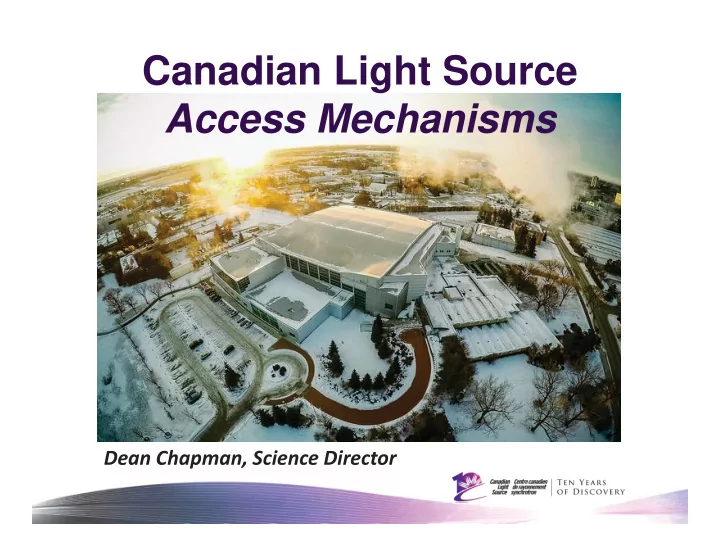

Canadian Light Source Access Mechanisms Dean Chapman, Science Director
International CLS users
But where are the biggest users (Researchers) Users come from International Users Non SK Canada 19% 35% SK Users 46%
Applications Energy Agriculture 4% Mining 10% Aerospace 23% 4% Auto 8% Other 8% Oil/Gas 19% Materials 14% Pharma 10%
CLS Access CLS followed established best practice in the synchrotron world 1. Most synchrotrons have purchased access 2. Most synchrotrons have a “partner user” access mechanism, where those who provide money and expertise get preferred access 3. Most have a peer review of proposal access
Purchased Access Up to 25% of beamtime on each beamline is available for purchased access Fees are negotiated with the CLS Industrial Group Beamteam Access Beamteams: academics who provide support, advice and funding Up to 25% of beamtime available to a beamteam, documented in an MOU Beamteam access reviewed by external review panels All fully operational beamlines & beamteams will be reviewed in November 2015
General User Access >30% of beamtime on each beamline Publish or intend to publish! Scientific peer reviewed proposals twice per year At least 3 external reviewers, and up to 7 Database of several hundred reviewers Reviewers selected by external Peer Review committee Proposals scored primarily on scientific merit Peer Review Committee Selects reviewers, checks proposal scores for consistency reviews proposals with one outlying score – decide whether to discount that review. Peer Review & Allocation Committees are separated – CLS takes responsibility for awarding beamtime
Do’s and Don’ts Do’s External committee members at arms length No “power users” or beamteam leaders No members from the University of Saskatchewan Make it clear: “knowing the right people” does not help Be transparent representatives from the User Advisory Committee are invited to observe both Peer Review and Allocation Peer Review Committee members named on our website. Have an established complaint mechanism to handle PIs who don’t get beamtime – include a neutral party we use the User Advisory Committee
Do’s and Don’ts Don’ts DON’T try and keep everybody happy if users think they will always get beamtime, where’s their incentive to publish ? DON’T ask your scientists who work with users to be peer reviewers – stops them being partners with the users, both literally and figuratively. DON’T assume everyone knows you have a fair process Talk about it! Users will always assume some other factor than how poor their proposal was, is responsible for them not getting time.
Recommend
More recommend